Affiliate links on Android Authority may earn us a commission. Learn more.
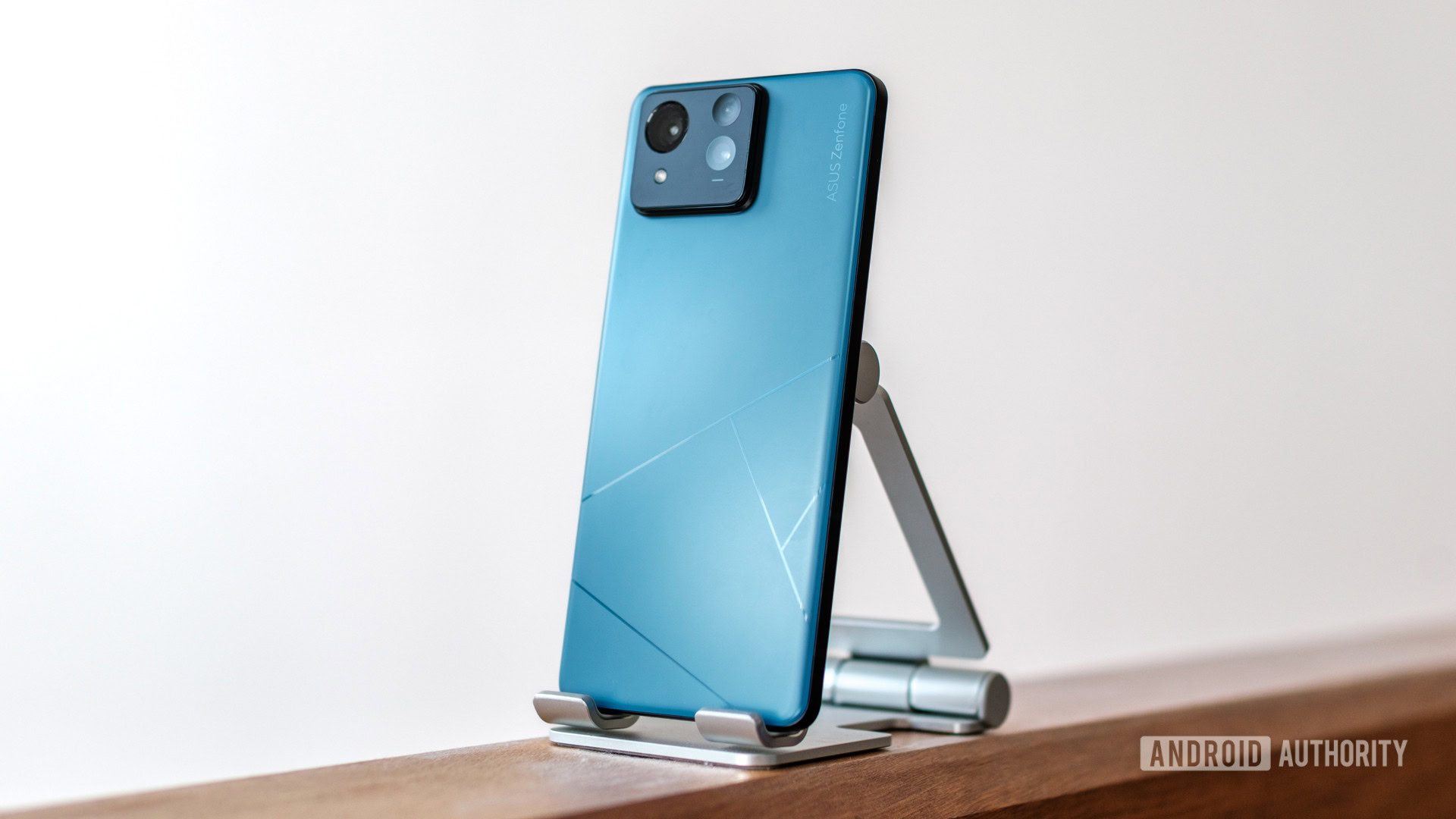


Asus Zenfone 11 Ultra
MSRP: $899.99
What we like
What we don't like

Asus Zenfone 11 Ultra
ASUS Zenfone 11 Ultra review: At a glance
- What is it? The ASUS Zenfone 11 Ultra is the successor to the compact Zenfone 10, but it's built in a completely different guise. With a much larger 6.78-inch form factor, triple camera array, and premium aesthetic, the phone brings Zenfone series favorites and new additions to a larger display.
- What is the price? The ASUS Zenfone 11 Ultra starts at $899 (£869/€999) for the 256GB storage model, while the 512GB version costs £950/€1,099. ASUS has a pre-order discount starting at just €899 if you order before April 14, 2024. US pre-orders bundle a pair of Cetra TWS earbuds.
- Where can you buy it? You can buy the ASUS Zenfone 11 Ultra from ASUS directly, Mobile Advance, Amazon, and select local channel partners starting on April 14, 2024. Pre-orders begin on March 14 in Europe, Hong Kong, Taiwan, and the US.
- How did we test it? I tested the ASUS Zenfone 11 Ultra for 10 days. The review unit was supplied by ASUS.
- Is it worth it? The ASUS Zenfone 11 Ultra cribs very closely from the gaming-focused ROG Phone 8 Pro. It's an Android flagship that won't feel all that new to ASUS fans and it'll disappoint anyone looking for another compact flagship, but it successfully streamlines the Zenfone experience for a more mainstream buyer. Multiday battery life, new AI extras, and a cheaper entry price tag will suit most customers much better than RGB lighting, after all. Better yet, the latest Zenfone undercuts big Galaxy and iPhone handsets, making it a solid value buy for demanding users even with the price increase over the Zenfone 10.
Should you buy the ASUS Zenfone 11 Ultra?
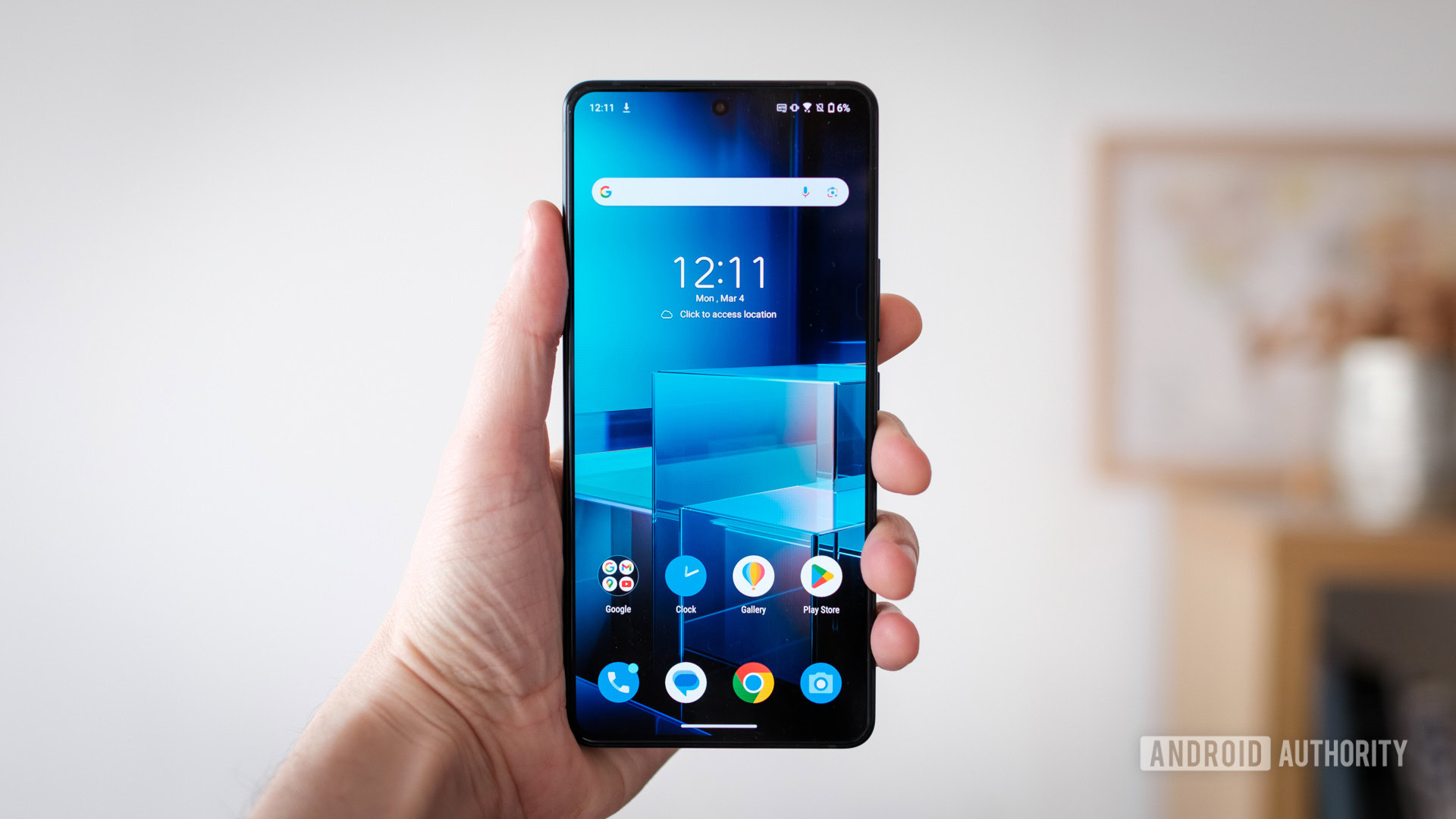
ASUS is charting a new course for the Zenfone range with the 11 Ultra. Gone is the series’ recent signature compact stature, replaced with a look and sheer size that’s much more ROG than Zen. Whether we’ll see a non-Ultra take on Zenfone with a smaller form factor again at a later date is up in the air — ASUS isn’t telling for now. Regardless, ASUS is in for a tough job differentiating its new flagship from the already excellent ROG Phone 8 Pro, but there are a few key changes compared to the brand’s elite gaming phone.
Perhaps the most obvious is the glass finish. Gone is the old Zenfone matte (which you’ll still receive on the latest ROG), resulting in a sleeker feel in the hand. Thankfully, Zenfone feature favorites remain, including the back-tap gesture shortcuts and the signature headphone jack here. The lack of a side-mounted fingerprint scanner means no swipe gestures, but you do receive a snappy in-display model in its place.
A Qualcomm Snapdragon 8 Gen 3 processor powers the handset, offering an impressive combination of responsiveness, gaming performance, and battery life. My testing pegs this as a chart-topping chipset implementation and every bit as competitive with ASUS’ gaming model. The only real loss for gamers is the lack of the secondary USB-C port, which makes the Zenfone 11 Ultra incompatible with ASUS’ AeroCooler accessory that keeps the ROG from throttling at high temperatures. You won’t find shoulder-mounted AirTriggers, the advanced internal cooling system, or RGB lighting here, either. This is a far more mainstream take on the formula.
ASUS' Zenfone 11 Ultra is a gargantuan phone built to perform.
Out of the box, ASUS sticks the phone in Dynamic performance mode. This seems to hold the CPU back a bit, providing performance that’s closer to 2023’s 8 Gen 2 flagships than a flat-out 8 Gen 3 — a trait we also saw on the OnePlus 12. Not that you’ll notice any performance issues breezing through apps or playing the latest games. You can run the CPU and GPU at full tilt via Performance mode, though this comes at the cost of additional battery drain and higher temperatures during our stress test benchmarks.
Furthermore, the change in form factor allows ASUS to include a much larger battery: 5,500mAh, up from 4,300mAh with the Zenfone 10. As you’d expect, the Zenfone 11 Ultra has excellent battery life; I could easily extend it into a second day when not shooting many pictures and videos. ASUS claims that the Zenfone 11 Ultra lasts up to 26% longer than its predecessor in its mixed ‘day of use’ test. My investigation reveals this heavily depends on what you’re doing. The Zenfone 11 Ultra’s big battery is largely canceled out by its more powerful hardware in demanding use cases like video recording and Zoom calls. Still, this phone is plenty frugal with battery life and provides superior screen-on time in our web browsing and video playback tests.
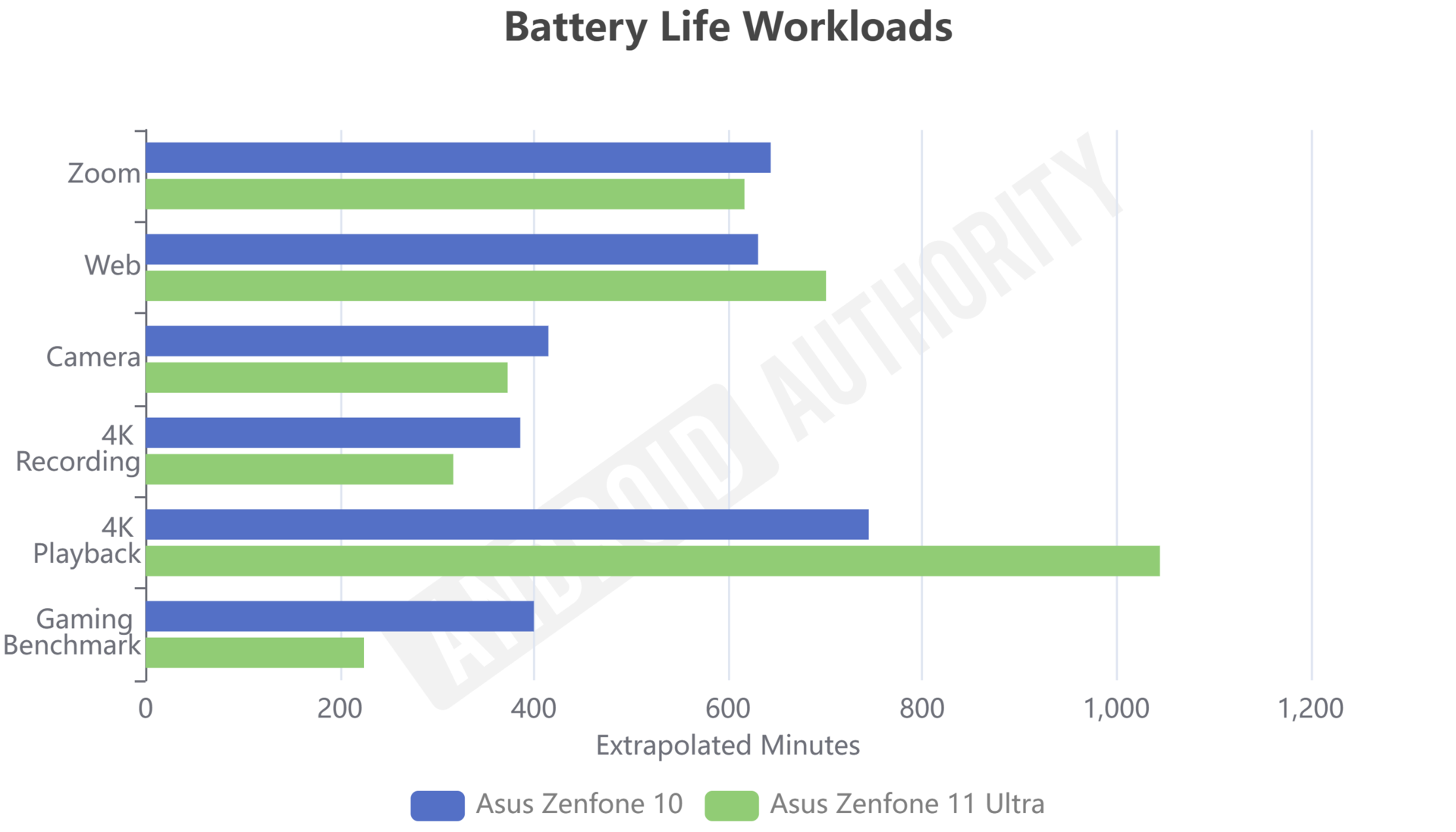
ASUS doesn’t include a wall plug in the box with the Zenfone 11 Ultra, so you’ll have to bring your own USB charger. If you charge from a 30W charger, such as those shipped with previous Zenfone models, it takes 64 mins to fill the phone and a rather so-so 28 minutes to hit 50% in my testing. Not bad, but not fast. Use a more powerful 65W version from the ROG series or other USB PD PSS compatible plug, and you hit full in a much faster 45 minutes and have 50% battery, about enough for a light day, in just 17 minutes.
Another piece of hardware that hasn’t changed much is the camera (see full-res samples in this Google Drive folder). This is the same setup as the ROG Phone 8 Pro, so we’re mostly retreading my previous thoughts here. but there are a few software additions to get into. Up front, exposure and white balance are very good, including selfies thanks to the RGBW sensor. ASUS’s triple camera setup ensures you can take fine-looking snaps in most environments, and image quality is very reasonable for a phone of this price.
I have notes, though. The main camera holds up the best in terms of detail, natural bokeh, and color reproduction, but some images can be too heavy on contrast and color saturation for my tastes. I’m unsure if this is the camera’s object segmentation technology simply being overzealous in some scenes. The ultrawide and 3x telephoto cameras are useful in daylight. Still, you’ll see a noticeable color shift between the three lenses (the ultrawide is particularly oversaturated), and their level of detail isn’t pristine. The same goes for the selfie camera with dimmer indoor lighting; it’s better than some but lacks fine detail in less-than-ideal conditions.
ASUS touts 30x long-distance photography with the aid of Hyperclarity deep learning models. 30x is an absolute no-go; even AI cannot inject detail at this range from a 3x optical zoom camera. Hyperclarity is active as low as 10x, though, and you’ll notice a bump in quality (along with extra dither/noise) that makes pictures at this range usable, providing you have decent lighting to begin with. I’m not sure why ASUS doesn’t use this technology below 10x because there’s an obvious jump in image quality versus 9.9x, and even 5x and 6x snaps would benefit from some upscaling for extra detail. Zoom is a mixed bag then, I tended to just stick to 3x during my time with the phone.
Photos and video are closing the gap with the big players, but there are still caveats.
The Zenfone 11 Ultra is a bit more cutting-edge in terms of video. Six-axis Hybrid Gimbal stabilization with Hypersteady technology, as seen on the Zenfone 10, ensures that even the most juddery videographers come out with silky smooth footage. It works as well as advertised, but the strongest Hypersteady effect is reserved for 1080p video. You can still use the Adaptive and hardware-only stabilization options at 4K and 8K, which, honestly, are usually good enough. AI Portrait Video is a new feature, infusing real-time software bokeh into your 4K video. Like all implementations we’ve seen so far, edge detection is hit-and-miss with fast-moving objects. Still, the bokeh effect looks nice and the mostly seamless focus transitions are wonderful for adding a little extra creativity to your videos.
Sadly there are caveats here too. 8K and 4K at 60fps options are locked to the main lens only, and you’ll have to settle for 1080p footage if you want to use the 3x telephoto. Lens transitions are also far from seamless, which takes the shine off the package.
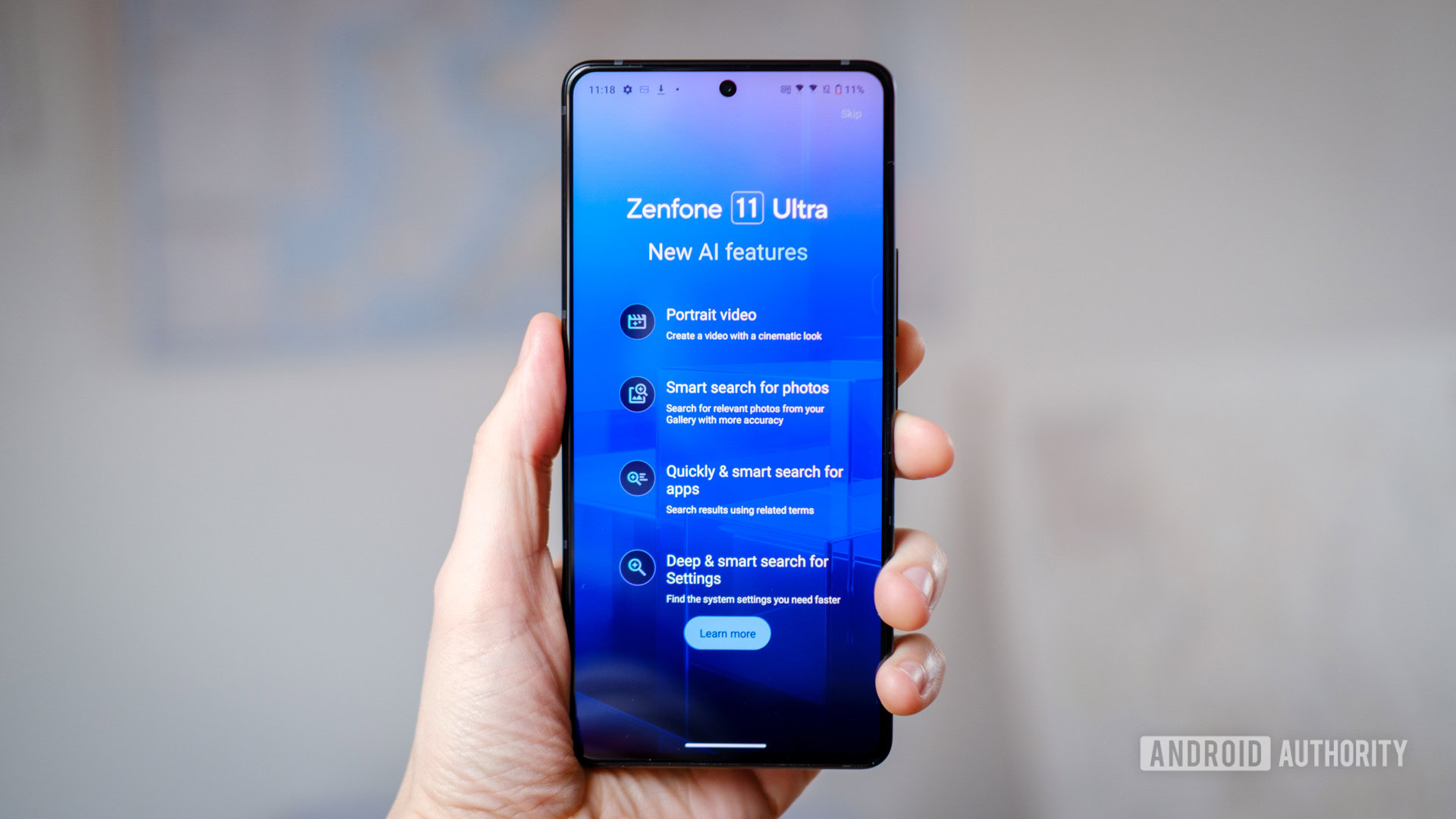
Underneath the familiar hardware, the ASUS Zenfone 11 Ultra pushes the brand’s Zen UI Android skin in a new direction. There is a familiar assortment of customization options, including a new left/right notification/quick setting split mode, that deviates ever so slightly from a Google-esque take on Android 14. However, as is the current trend, ASUS augments this familiar setup with some new AI-powered features. We’re not talking quite as extensive as the AI suites you’ll find on Google’s Pixel 8 or Samsung’s Galaxy S24 series, but there’s some similarly impressive AI tech coming to the Zenfone 11 Ultra in a future update. ASUS provided us with preview builds of the technology on our review unit.
With AI-onboard, the Zenfone 11 Ultra pushes software in a new direction too.
For instance, AI Transcript will feel very familiar to anyone who’s looked at the S24 series. After a slight delay, ASUS recorder app converts audio to text on-device and can use the cloud to generate audio summaries. Chinese, English, French, German, Spanish, Portuguese, Italian, and Japanese languages are supported. AI Call Translator works in a similar fashion, translating calls in real-time, on-device, for both you and the person on the other end, even if they don’t have a Zenfone. Unfortunately, I wasn’t able to test this feature.
We’ve seen ASUS’ other AI features before. AI Noise Cancellation works on a broader set of apps, such as Whatsapp or Telegram, reducing background noise for both incoming and outgoing audio. AI Wallpaper brings you abstract, textures, cityscape, nature, space, sci-fi, and “amaze me” themes, but they can look a bit samey. Meanwhile, Semantic Search allows you to use natural language to search the phone’s settings menu, apps, and ASUS Gallery images.
Of course, you should never buy a device with the promise of future features, so hopefully, they will arrive very soon. Speaking of, ASUS commits to “at least” two OS upgrades and four years of security updates with the Zenfone 11 Ultra. That would have been a decent update policy two or three years ago, but it falls far short of the seven years of updates offered by Google and Samsung flagships at this price. Four years covers a typical upgrade cycle, but those after a really long-term purchase should look elsewhere.
Overall, I liked ASUS’ ROG Phone 8 Pro for successfully marrying gamer needs with more mainstream features, and the Zenfone 11 Ultra takes essentially the same formula a step further. With AI extras and some welcome savings over ASUS’ beefy gaming phone, this version will suit most users much better.


What are the best ASUS Zenfone 11 Ultra alternatives?
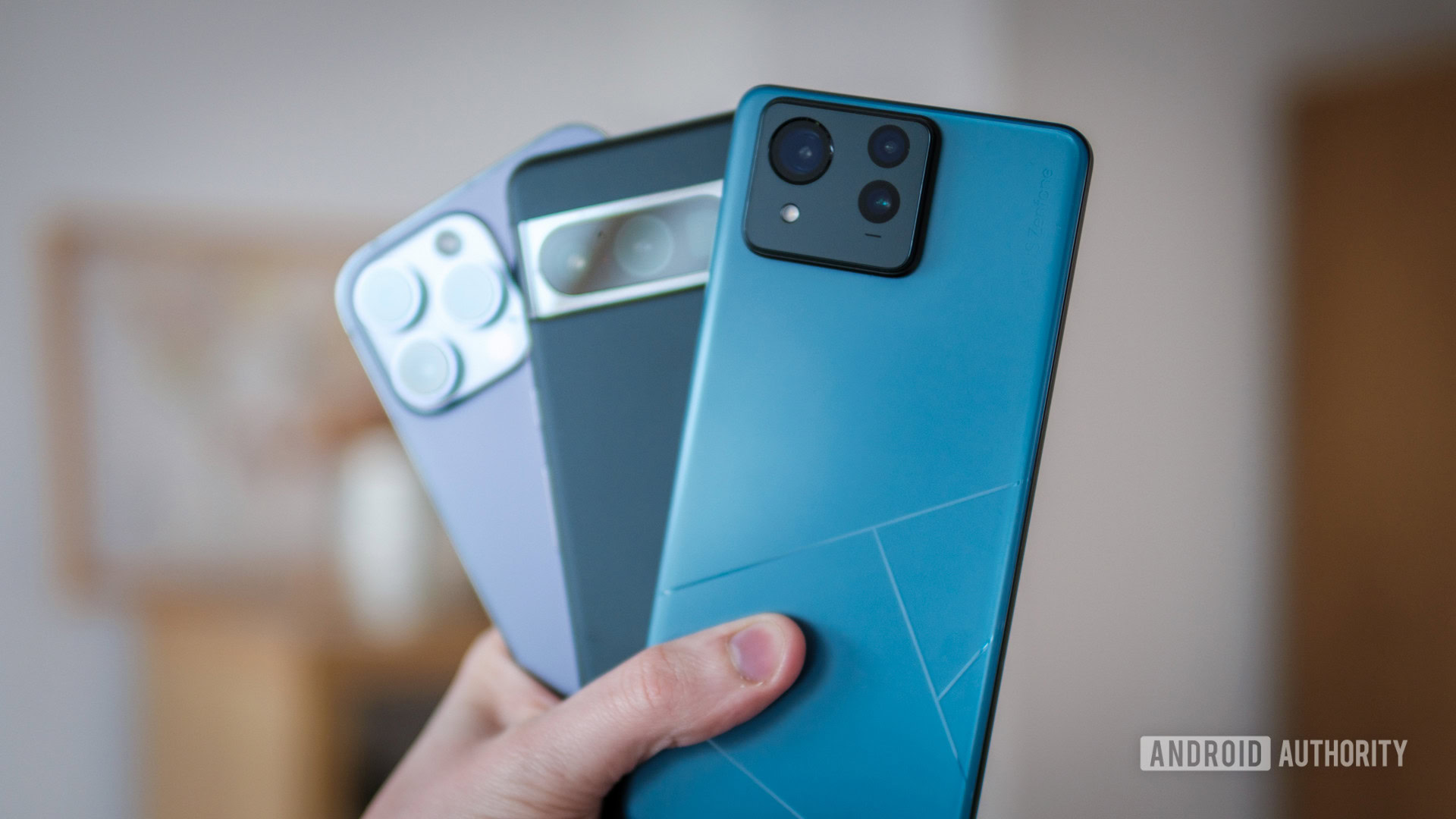
Starting at $899, the ASUS Zenfone 11 Ultra undercuts the key power user players, including the Samsung Galaxy S24 Plus and Apple iPhone 15 Plus. That stands ASUS’s flagship in good stead, but there are still reasons to have your eye on the competition.
- Samsung Galaxy S24 Plus ($1119.99 at Amazon): Samsung Galaxy S24 Plus scores a few small wins, with a marginally more consistent camera and additional AI features. The Zenfone 11 Ultra charges faster, has a bigger battery, and performs better under heavy stress. Still, when you’re making this sort of investment, a phone with seven years of updates is hard to ignore, even if it costs a little more upfront.
- Google Pixel 8 Pro ($999 at Amazon): When talking AI and photography capabilities, Google’s Pixel 8 Pro flagship is one of the best in the business, offering media editing capabilities that go beyond ASUS’s AI tools. That said, it certainly doesn’t offer the same level of performance, battery life, or charging speed as the Zenfone 11 Ultra, and it even costs a little more as well.
- Apple iPhone 15 Plus ($899 at Apple): When you’re spending big bucks on a big phone, Apple’s gargantuan models are always in the frame. The Pro Max is another step up the price rung, but the iPhone 15 Plus still offers a solid camera setup, superb performance, excellent battery life, and long-term update support.
- OnePlus 12 ($899.99 at Amazon): If you’re looking for a similarly priced alternative with super fast charging and high-end performance, the OnePlus 12 ticks the key boxes and offers longer support. Its camera is still so-so, the IP65 rating isn’t as robust, and there are no AI features like the Zenfone, so it’s a case of pros and cons.
- ASUS Zenfone 10 ($699.99 at Amazon): As ASUS’ reps pointed out to us, the compact Zenfone 10 only came out last July and is still alive and kicking. You’ll trade down the telephoto camera, faster charging, and latest Snapdragon processor but gain the Zenfone 10’s lovely compact stature and a significant cash saving, especially if you can find a good deal on it.
ASUS Zenfone 11 Ultra specs
| Asus Zenfone 11 Ultra | |
|---|---|
Display | 6.78-inch AMOLED, FHD+ resolution (2,340 x 1,080) 120Hz display refresh rate (1Hz-120Hz) HDR10+ Peak brightness 2,500 nits HBM brightness 1,600 nits |
Processor | Qualcomm Snapdragon 8 Gen 3 |
RAM | 12GB, 16GB LPDDR5X |
Storage | 256GB, 512GB UFS4.0 |
Battery | 5,500mAh |
Power | 65W wired charging (PPS) 15W wireless charging (Qi) No charger in box |
Cameras | Rear: - 50MP main f/1.9 1/1.56-inch sensor 6-axis Hybrid Gimbal Stablization - 13MP ultrawide F/2.2. 120-degree FoV Freeform lens - 32MP telephoto 3x optical zoom F/2.2 OIS Front: - 32MP 1.12 μm pixel size RGBW sensor |
Video | Rear: 8K at 24fps (main lens only) 4K at 60fps (main lens only) 4K at 30fps (all lenses) Front: 1080p at 30fps |
Audio | Stereo speakers 3.5mm headphone jack Dirac Virtuo AptX Adpative, Lossless, HD |
Connectivity | 5G (Sub6) Wi-Fi 7 Ready Bluetooth 5.4 NFC GPS/GNSS/GLONASS/Galileo/Beidou/QZSS/NavIC |
SIM | Dual Nano SIM |
Security | Ultrasonic under-display fingerprint sensor |
Durability | IP68 Gorilla Glass Victus 2 on the front Aluminum frame |
Software | Android 14 ZenUI |
Update Policy | 2 years of OS update 4 years of security updates |
Dimensions and weight | 163.8 x 76.8 x 8.9mm 224g |
Colors | Misty Grey, Skyline Blue, Eternal Black, Desert Sand |
ASUS Zenfone 11 Ultra review: FAQ
No. The Zenfone 11 Ultra has two physical nano-SIM slots.
ASUS promises at least two years of OS upgrades and four years of security updates for the Zenfone 11 Ultra.
Yes, the ASUS Zenfone 11 Ultra has an IP68 rating for water and dust resistance.
Yes, the ASUS Zenfone 11 Ultra supports wireless charging at up to 15W with compatible Qi chargers.
Yes, the ASUS Zenfone 11 Ultra has a 3.5mm headphone jack located on the bottom of the phone.